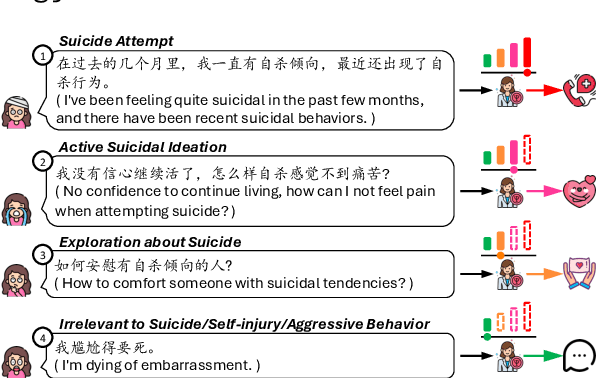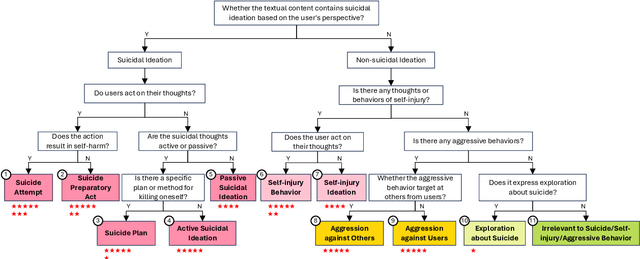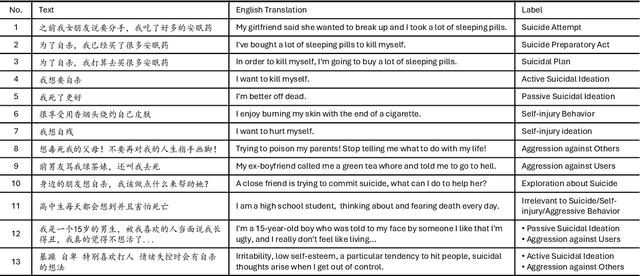Zhenzhong Lan
Do PhD-level LLMs Truly Grasp Elementary Addition? Probing Rule Learning vs. Memorization in Large Language Models
Apr 07, 2025Abstract:Despite high benchmark scores, Large Language Models (LLMs) often fail simple problem, raising a critical question: Do LLMs learn mathematical principles or merely memorize patterns? Rather than designing increasingly complex benchmarks like recent works, we investigate this using elementary two-integer addition ($0$ to $2^{64}$), probing two core properties: commutativity ($A+B=B+A$) and compositional generalization (via isomorphic symbolic mappings, e.g., $7 \rightarrow y$). While state-of-the-art LLMs achieve 73.8-99.8\% accuracy on numerical addition, performance collapses to $\leq$7.5\% under symbolic mapping, indicating failure to generalize learned rules. Non-monotonic performance scaling with digit count and frequent commutativity violations (over 1,700 cases of $A+B \neq B+A$) further support this. Explicitly providing addition rules degrades performance by 81.2\% on average, while self-explanation maintains baseline accuracy, suggesting LLM arithmetic processing is misaligned with human-defined principles. Our findings indicate current LLMs rely on memory pattern over genuine rule learning, highlighting architectural limitations and the need for new approaches to achieve true mathematical reasoning.
Enhancing Chest X-ray Classification through Knowledge Injection in Cross-Modality Learning
Feb 19, 2025Abstract:The integration of artificial intelligence in medical imaging has shown tremendous potential, yet the relationship between pre-trained knowledge and performance in cross-modality learning remains unclear. This study investigates how explicitly injecting medical knowledge into the learning process affects the performance of cross-modality classification, focusing on Chest X-ray (CXR) images. We introduce a novel Set Theory-based knowledge injection framework that generates captions for CXR images with controllable knowledge granularity. Using this framework, we fine-tune CLIP model on captions with varying levels of medical information. We evaluate the model's performance through zero-shot classification on the CheXpert dataset, a benchmark for CXR classification. Our results demonstrate that injecting fine-grained medical knowledge substantially improves classification accuracy, achieving 72.5\% compared to 49.9\% when using human-generated captions. This highlights the crucial role of domain-specific knowledge in medical cross-modality learning. Furthermore, we explore the influence of knowledge density and the use of domain-specific Large Language Models (LLMs) for caption generation, finding that denser knowledge and specialized LLMs contribute to enhanced performance. This research advances medical image analysis by demonstrating the effectiveness of knowledge injection for improving automated CXR classification, paving the way for more accurate and reliable diagnostic tools.
UBER: Uncertainty-Based Evolution with Large Language Models for Automatic Heuristic Design
Dec 30, 2024



Abstract:NP-hard problem-solving traditionally relies on heuristics, but manually crafting effective heuristics for complex problems remains challenging. While recent work like FunSearch has demonstrated that large language models (LLMs) can be leveraged for heuristic design in evolutionary algorithm (EA) frameworks, their potential is not fully realized due to its deficiency in exploitation and exploration. We present UBER (Uncertainty-Based Evolution for Refinement), a method that enhances LLM+EA methods for automatic heuristic design by integrating uncertainty on top of the FunSearch framework. UBER introduces two key innovations: an Uncertainty-Inclusive Evolution Process (UIEP) for adaptive exploration-exploitation balance, and a principled Uncertainty-Inclusive Island Reset (UIIS) strategy for maintaining population diversity. Through extensive experiments on challenging NP-complete problems, UBER demonstrates significant improvements over FunSearch. Our work provides a new direction for the synergy of LLMs and EA, advancing the field of automatic heuristic design.
OpenWebVoyager: Building Multimodal Web Agents via Iterative Real-World Exploration, Feedback and Optimization
Oct 25, 2024



Abstract:The rapid development of large language and multimodal models has sparked significant interest in using proprietary models, such as GPT-4o, to develop autonomous agents capable of handling real-world scenarios like web navigation. Although recent open-source efforts have tried to equip agents with the ability to explore environments and continuously improve over time, they are building text-only agents in synthetic environments where the reward signals are clearly defined. Such agents struggle to generalize to realistic settings that require multimodal perception abilities and lack ground-truth signals. In this paper, we introduce an open-source framework designed to facilitate the development of multimodal web agent that can autonomously conduct real-world exploration and improve itself. We first train the base model with imitation learning to gain the basic abilities. We then let the agent explore the open web and collect feedback on its trajectories. After that, it further improves its policy by learning from well-performing trajectories judged by another general-purpose model. This exploration-feedback-optimization cycle can continue for several iterations. Experimental results show that our web agent successfully improves itself after each iteration, demonstrating strong performance across multiple test sets.
Value Residual Learning For Alleviating Attention Concentration In Transformers
Oct 23, 2024Abstract:Transformers can capture long-range dependencies using self-attention, allowing tokens to attend to all others directly. However, stacking multiple attention layers leads to attention concentration. One natural way to address this issue is to use cross-layer attention, allowing information from earlier layers to be directly accessible to later layers. However, this approach is computationally expensive. To address this problem, we propose Transformer with residual value (ResFormer) which approximates cross-layer attention through adding a residual connection from the values of the the first layer to all subsequent layers. Based on this method, one variant is the Transformer with single layer value (SVFormer), where all layers share the same value embedding from first layer, reducing the KV cache by nearly 50%. Comprehensive empirical evidence demonstrates that ResFormer mitigates attention concentration problem in deeper layers and enhances representation across most layers, outperforming the vanilla Transformer, DenseFormer, and NeuTRENO in training error as well as downstream tasks. SVFormer trains significantly faster than the vanilla Transformer and performs better than other methods like GQA and CLA, with performance influenced by sequence length and cumulative learning rate.
Nova: An Iterative Planning and Search Approach to Enhance Novelty and Diversity of LLM Generated Ideas
Oct 18, 2024Abstract:Scientific innovation is pivotal for humanity, and harnessing large language models (LLMs) to generate research ideas could transform discovery. However, existing LLMs often produce simplistic and repetitive suggestions due to their limited ability in acquiring external knowledge for innovation. To address this problem, we introduce an enhanced planning and search methodology designed to boost the creative potential of LLM-based systems. Our approach involves an iterative process to purposely plan the retrieval of external knowledge, progressively enriching the idea generation with broader and deeper insights. Validation through automated and human assessments indicates that our framework substantially elevates the quality of generated ideas, particularly in novelty and diversity. The number of unique novel ideas produced by our framework is 3.4 times higher than without it. Moreover, our method outperforms the current state-of-the-art, generating at least 2.5 times more top-rated ideas based on 170 seed papers in a Swiss Tournament evaluation.
PsyGUARD: An Automated System for Suicide Detection and Risk Assessment in Psychological Counseling
Sep 30, 2024



Abstract:As awareness of mental health issues grows, online counseling support services are becoming increasingly prevalent worldwide. Detecting whether users express suicidal ideation in text-based counseling services is crucial for identifying and prioritizing at-risk individuals. However, the lack of domain-specific systems to facilitate fine-grained suicide detection and corresponding risk assessment in online counseling poses a significant challenge for automated crisis intervention aimed at suicide prevention. In this paper, we propose PsyGUARD, an automated system for detecting suicide ideation and assessing risk in psychological counseling. To achieve this, we first develop a detailed taxonomy for detecting suicide ideation based on foundational theories. We then curate a large-scale, high-quality dataset called PsySUICIDE for suicide detection. To evaluate the capabilities of automated systems in fine-grained suicide detection, we establish a range of baselines. Subsequently, to assist automated services in providing safe, helpful, and tailored responses for further assessment, we propose to build a suite of risk assessment frameworks. Our study not only provides an insightful analysis of the effectiveness of automated risk assessment systems based on fine-grained suicide detection but also highlights their potential to improve mental health services on online counseling platforms. Code, data, and models are available at https://github.com/qiuhuachuan/PsyGUARD.
Interactive Agents: Simulating Counselor-Client Psychological Counseling via Role-Playing LLM-to-LLM Interactions
Aug 28, 2024Abstract:Virtual counselors powered by large language models (LLMs) aim to create interactive support systems that effectively assist clients struggling with mental health challenges. To replicate counselor-client conversations, researchers have built an online mental health platform that allows professional counselors to provide clients with text-based counseling services for about an hour per session. Notwithstanding its effectiveness, challenges exist as human annotation is time-consuming, cost-intensive, privacy-protected, and not scalable. To address this issue and investigate the applicability of LLMs in psychological counseling conversation simulation, we propose a framework that employs two LLMs via role-playing for simulating counselor-client interactions. Our framework involves two LLMs, one acting as a client equipped with a specific and real-life user profile and the other playing the role of an experienced counselor, generating professional responses using integrative therapy techniques. We implement both the counselor and the client by zero-shot prompting the GPT-4 model. In order to assess the effectiveness of LLMs in simulating counselor-client interactions and understand the disparities between LLM- and human-generated conversations, we evaluate the synthetic data from various perspectives. We begin by assessing the client's performance through automatic evaluations. Next, we analyze and compare the disparities between dialogues generated by the LLM and those generated by professional counselors. Furthermore, we conduct extensive experiments to thoroughly examine the performance of our LLM-based counselor trained with synthetic interactive dialogues by benchmarking against state-of-the-art models for mental health.
Predicting the Big Five Personality Traits in Chinese Counselling Dialogues Using Large Language Models
Jun 25, 2024Abstract:Accurate assessment of personality traits is crucial for effective psycho-counseling, yet traditional methods like self-report questionnaires are time-consuming and biased. This study exams whether Large Language Models (LLMs) can predict the Big Five personality traits directly from counseling dialogues and introduces an innovative framework to perform the task. Our framework applies role-play and questionnaire-based prompting to condition LLMs on counseling sessions, simulating client responses to the Big Five Inventory. We evaluated our framework on 853 real-world counseling sessions, finding a significant correlation between LLM-predicted and actual Big Five traits, proving the validity of framework. Moreover, ablation studies highlight the importance of role-play simulations and task simplification via questionnaires in enhancing prediction accuracy. Meanwhile, our fine-tuned Llama3-8B model, utilizing Direct Preference Optimization with Supervised Fine-Tuning, achieves a 130.95\% improvement, surpassing the state-of-the-art Qwen1.5-110B by 36.94\% in personality prediction validity. In conclusion, LLMs can predict personality based on counseling dialogues. Our code and model are publicly available at \url{https://github.com/kuri-leo/BigFive-LLM-Predictor}, providing a valuable tool for future research in computational psychometrics.
Unveiling the Impact of Multi-Modal Interactions on User Engagement: A Comprehensive Evaluation in AI-driven Conversations
Jun 21, 2024Abstract:Large Language Models (LLMs) have significantly advanced user-bot interactions, enabling more complex and coherent dialogues. However, the prevalent text-only modality might not fully exploit the potential for effective user engagement. This paper explores the impact of multi-modal interactions, which incorporate images and audio alongside text, on user engagement in chatbot conversations. We conduct a comprehensive analysis using a diverse set of chatbots and real-user interaction data, employing metrics such as retention rate and conversation length to evaluate user engagement. Our findings reveal a significant enhancement in user engagement with multi-modal interactions compared to text-only dialogues. Notably, the incorporation of a third modality significantly amplifies engagement beyond the benefits observed with just two modalities. These results suggest that multi-modal interactions optimize cognitive processing and facilitate richer information comprehension. This study underscores the importance of multi-modality in chatbot design, offering valuable insights for creating more engaging and immersive AI communication experiences and informing the broader AI community about the benefits of multi-modal interactions in enhancing user engagement.
 Add to Chrome
Add to Chrome Add to Firefox
Add to Firefox Add to Edge
Add to Edge